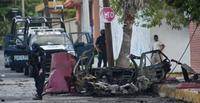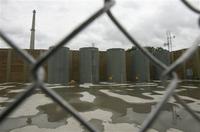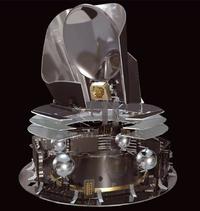-
Dynasil wins DHS award for radiation detection
Dynasil Corporation’s research division, Radiation Monitoring Devices, Inc. (RMD), was recently named DHS’ small business winner for radiation and nuclear detection for 2011; the award is meant to honor small businesses that are excelling in innovative achievement and demonstrate a commitment to national security; RMD was recognized particularly for its development of two new radiation detection materials, strontium iodide and CLYC crystals; DHS is especially keen to develop these new radiation detection materials as the current industry standard, helium-3, is suffering from major shortages
-
-
Improving safety in the presence of chemical hazards
A new kind of sensor could warn emergency workers when carbon filters in the respirators they wear to avoid inhaling toxic fumes have become dangerously saturated; first responders protect themselves from such vapors, whose composition is often unknown, by breathing through a canister filled with activated charcoal — a gas mask; airborne toxins stick to the carbon in the filter, trapping the dangerous materials, and as the filters become saturated, chemicals will begin to pass through; the respirator can then do more harm than good by providing an illusion of safety
-
-
Fears over nuclear energy stall Kentucky nuclear plans
Days before the 11 March earthquake and tsunami struck Japan causing its ongoing nuclear crisis, a bill that would have eased restrictions on the construction of a nuclear power plant in Kentucky failed to pass the state legislature dashing the hopes of atomic energy advocates; the proposed site currently houses a uranium enrichment facility, but it is expected to be shut down in the near future leaving 1,200 people out of work; safety advocates are concerned because the site is located near the New Madrid seismic zone; Kentucky generates 90 percent of its power from coal, and Governor Beshear proposed in 2008 to use nuclear power to generate 30 percent of the state’s energy by 2030
-
-
Car-based IED attacks an emerging threat in Mexico

Intelligence analysts worry that Mexican drug cartels will increasingly turn to deadly car bombs in the escalating drug wars; drug cartels have already assassinated several government officials using improvised explosive devices (IEDs) planted in cars; in Mexico IEDs are easy to construct due to easy access to powerful commercial explosives that are widely used in the country’s mining and petroleum industry; due to strict gun laws, it is actually cheaper and easier to obtain explosives than guns; to defend against this emerging threat the U.S. consulate in Monterrey erected concrete barriers
-
-
Gamma rays search for concealed nuclear threats
Gamma rays are the most energetic type of light wave and can penetrate through lead and other thick containers; in the last couple of years, MEGa-ray prototypes have identified elements like lithium and lead hidden behind metal barriers; the next generation of MEGa-ray machines, which should come on-line in a couple of years, will be a million times brighter, allowing them to see through thick materials to locate specific targets in less than a second
-
-
Magnetic "nanobeads" detect chemical and biological agents
Researchers at Oregon State University have found a way to use magnetic “nanobeads” to help detect chemical and biological agents, with possible applications in everything from bioterrorism to medical diagnostics, environmental monitoring, or even water and food safety; rapid detection of chemical toxins used in bioterrorism would be possible, including such concerns as anthrax, ricin or smallpox, where immediate, accurate and highly sensitive tests would be needed
-
-
Virtual Imaging: versatile detection at low radiation dosage
Virtual Imaging, a Canon U.S.A. Company, is offering its RadPRO SecurPASS, a full body security screening system that detects and recognizes a range of objects and materials in about eight seconds per person; it uses transmission imaging with an exceptionally low dose of X-rays to scan for dangerous or illegal substances such as liquid explosives, drugs, copper wires, plastic, etc.; its applications range from civil security, that is, airports, seaports, railways, bus stations, to border security, prison security, and high level security as necessitated by nuclear power plants, military premises, and embassies
-
-
Indian explosives detection technology comes to U.S.
A south Carolina-based company signs a memorandum of understanding with India’s Defense Research and Development Organization (DRDO) to enhance the DRDO-developed Explosives Detection Kit (EDK) so it meets standards that will allowed it to be used by the U.S. military and homeland security
-
-
Sector Report for Monday, 25 April 2011: Detection
This report contains the following stories.
-
-
Insider threats in Afghanistan increase need for explosive detectors
In Afghanistan suicide bombers are increasingly disguising themselves as friendly forces to successfully infiltrate secure allied bases and wreak havoc; April has been a deadly month for allied troops in Afghanistan with at least four attacks taking place where suicide bombers disguised themselves as police officers or members of the army; to protect against this threat, Thermal Matrix specializes in person-borne improvised explosive device (PBIED) detection devices; the firm has been working with the U.S military for the past several years to develop the Thermal Matrix ACT system which is capable of detecting suicide bombers from long distances; the system uses infrared imagery to analyze the heat signature of approaching individuals to determine if they are carrying any explosives
-
-
British company purchases American IED detection firm for $90M
Last week the British defense firm Chemring finalized a deal to purchase Detection Systems, a subsidiary of General Dynamics, for $90 million; North Carolina based Detection Systems specializes in improvised explosive devices (IED) sensor systems; Detection Systems currently supplies the U.S. military with vehicle mounted IED detectors; the acquisition helps to enhance Chemring’s existing IED detection capabilities and provides growth opportunities for its chemical and biological detection programs; the purchase will not be finalized until the U.S. government reviews the proposal
-
-
Cooling pools or dry casks for nuclear waste: which is safer

There are two ways to store nuclear waste: in pools of water, where the densely packed uranium rods are cooled by a constant flow of circulating water, or in dry casks — typically barrel-shaped steel-and-concrete structures that stand twenty feet high and sit outdoors — where the uranium loosely packed rods are cooled by passive air; there are 65,000 tons of nuclear waste in the United States, more than in any other nation, and this amount grows by about 2,200 tons each year; the Fukushima disaster demonstrated that dry casks were able to withstand the 11 March combination of earthquake and tsunami much better than cooling pools; the U.S. Nuclear Regulatory Commission must now decide whether cooling pools are safe enough to store nuclear waste, and even whether densely packing nuclear waste is safe
-
-
Chernobyl radiation did not damage abundance, diversity of aquatic life
A new study of the lakes in and around Chernobyl’s fallout zone reveals that radiation from the nuclear accident appears to have had no long term effect on the abundance or diversity of aquatic animal life; no evidence was found that the abundance or diversity of the animal communities was influenced by direct contamination from the Chernobyl accident; indeed, the most contaminated lake, Glubokoye, 6.5 km north of the nuclear power plant, supported the most animal diversity of those lakes studied
-
-
Space technology of practical uses on Earth

Terahertz technology developed for space missions to study the most distant objects in the universe is now finding a host of practical applications back on Earth; most clothing and packaging materials are transparent to Terahertz radiation, whereas skin, water, metal and a host of other interesting materials are not; this gives rise to some important day-to-day applications: detecting weapons concealed under clothing or inside parcels; distinguishing skin and breast cancer tissue; quality control of manufactures items and processes in factories
-
-
Trees as contamination detectors
Determining the presence and concentration of contaminants has been an invasive, laborious process; now a Missouri University of Science and Technology team has developed a faster, more economical method of determining such contamination at miniscule levels; the Army has funded additional research for explosive residue detection
-
More headlines
The long view
Keeping the Lights on with Nuclear Waste: Radiochemistry Transforms Nuclear Waste into Strategic Materials
How UNLV radiochemistry is pioneering the future of energy in the Southwest by salvaging strategic materials from nuclear dumps –and making it safe.
Model Predicts Long-Term Effects of Nuclear Waste on Underground Disposal Systems
The simulations matched results from an underground lab experiment in Switzerland, suggesting modeling could be used to validate the safety of nuclear disposal sites.
